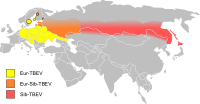
Photo from wikipedia
BackgroundDifferent tick species are able to transmit different pathogens, and tick-borne diseases are of substantial concern worldwide for both humans and animals. Environmental changes and changes in the range of… Click to show full abstract
BackgroundDifferent tick species are able to transmit different pathogens, and tick-borne diseases are of substantial concern worldwide for both humans and animals. Environmental changes and changes in the range of tick species, including Dermacentor reticulatus in Europe, can affect the spread of zoonotic pathogens. The aim of this study was to investigate the prevalence of the tick-borne pathogens in ticks removed from dogs in Latvia, and to explore possible changes between years 2011 and 2016.ResultsIn 2011, only Ixodes ticks (221 Ixodes ricinus and 22 Ixodes persulcatus) were collected from dogs, while in 2016 tick samples belonged to Ixodes ricinus (360), Ixodes persulcatus (2) and Dermacentor reticulatus (27) species. In total, 35.8 and 40.0% of adult ticks were pathogen-positive in 2011 and 2016, respectively; the difference was not statistically significant (P > 0.05). The molecular analysis indicated the presence of 13 tick-borne microorganisms; the most prevalent pathogen was Rickettsia, followed by Borrelia burgdorferi sensu lato group spirochetes, Anaplasma phagocytophilum and Babesia species. Borrelia miyamotoi was also present. A co-infection with two and three tick-borne pathogens was detected in 7.9 and 7.4% of Ixodes ricinus and Dermacentor reticulatus, respectively. The results of this study confirmed that the spread of novel vectors could bring additional risk of exposure to novel emerging pathogens to pets and their owners, as both Babesia canis and Rickettsia raoultii were shown to be highly associated with Dermacentor reticulatus ticks in Latvia.ConclusionsThis study demonstrates the potential danger from the inadvertent introduction of novel disease pathogens and vectors. Awareness of co-infections and Dermacentor reticulatus-related pathogens needs to be increased.
Journal Title: BMC Veterinary Research
Year Published: 2019
Link to full text (if available)
Share on Social Media: Sign Up to like & get
recommendations!